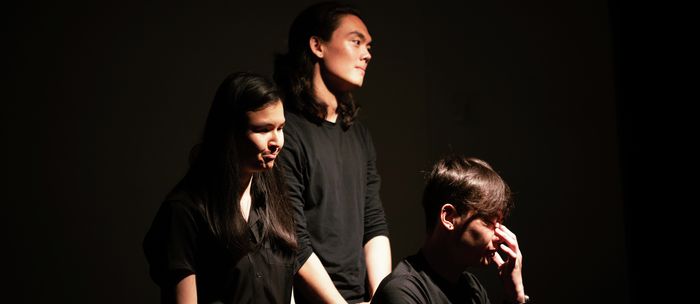Refashioning the Orient in M. Butterfly
Fashion Editor Anna Chan interviews Annie Ma, costume designer for the upcoming ADC main show M. Butterfly

Content Note: This article contains brief mention of suicide.
Red. Dragons. Lanterns. Fans. Origami. Silk.
This is China ‘through the looking glass’: exotic, Orientalised, fetishised, subordinate. Asia and the Asian woman are fetishised as ornaments—beautiful, docile, powerless, and disposable: in Puccini’s opera Madame Butterfly, Japanese woman Butterfly becomes infatuated with an American naval officer who abandons her and prompts her suicide.
“We need to show that stereotyped version of East Asia”
The play M. Butterfly by David Henry Hwang derives its name from the opera and embeds it meta-theatrically, and this upcoming production intentionally exaggerates these orientalist tropes. “We need to show that stereotyped version of East Asia,” costume designer Annie Ma explains, because the play is dominated by the character René Gallimard’s narrative, recounting his love story with China opera singer Song Liling as he serves a prison sentence for treason. He is intoxicated by the Oriental woman, and hence the entire story is ensconced in this fantasy. Song wears a kimono when she performs as Butterfly in the opera, hanfu (a traditional, dynastic silhouette of the Han Chinese), as well as a traditional Chinese opera costume—which for Annie was the largest practical challenge to source. The production is renting from the London Chinese Opera Studio to bring about an accurate and respectful depiction of the traditional costume.
Rather than attempting a utopia unmarred by imperialism by explicitly denying or subverting Orientalist aesthetics, Annie’s costuming acknowledges the weight they have in reality through perception: there are “very real issues that stem from a really long history of aesthetics [and] this idea of Orientalism.”
“It’s a play that’s aware of itself as a play, but there’s plays within plays within plays”
Nevertheless: “We wanted to pull away from the stereotypical aesthetics of Asia,” Annie tells me. “As an Asian person, [...] I can easily tell from my own end what’s accurate and what’s not, but that’s not the kind of audience we’re speaking to.” Just as Gallimard’s narrative is punctured and challenged throughout the play, the gritty, realistic aesthetics of 1960s Beijing also penetrate. Mao’s Cultural Revolution was launched in 1966, purging traditional Chinese art and ‘decadence’ as well as denouncing foreign aesthetics. This adds another tension on top of that between East and West, and “you can kind of show that journey through costuming as the play goes on.” Annie showcases that side of fashion history in juxtaposition with this de-historicised fantasy, dressing characters in the Zhongshan (or Mao) suit that combines Chinese and Western elements with the mandarin collar and four large pockets on the front.

Colour is another site of subversion, with Annie opting for rich greens and blues rather than stereotypical red while still remaining faithful to historical accuracy. The only character in vivid red is Helga, Gallimard’s wife incongruous both to his Orientalist fantasy and to the real China. “Wong Kar Wai’s In the Mood for Love is one of the main aesthetic influences that I personally drew [from] when thinking about how we show this world of 1960s China,” she says, featuring qipaos in lime green and sky blue that are “so ’60s, so mod but still in a very Asian way,” Annie lauds. The film being so “aesthetically rich” and “full of life and vibrancy” serves as inspiration for Song’s costumes when she’s at home in her most natural element, free from both the Orientalist gaze and stark Maoist China. The qipao itself encapsulates this: often misunderstood as an archaic Chinese garment, the dress in fact adapted Qing Manchu clothing as an androgynous iteration in the 1920s, and was later feminised and popularised as the garb of the modern woman.
As Annie and I discuss how Orientalism bears on our own identities, she professes: “My authentic perception of Asian fashion would be what feels most personal and real to me, what brings in aspects of my upbringing that isn’t catering to any sort of gaze.” M. Butterfly, however, is perhaps painfully aware of the gaze; it revels in, plays with and performs for this gaze. “There’s a lot of layers of performance in M. Butterfly—it’s a play that’s aware of itself as a play, but there’s plays within plays within plays.”
The performative power of clothing is emphasised in this production of M. Butterfly. One can be written, fetishised and dressed—or undressed—by others, but one can also play into these fantasies and construct new ones through performance and presentation. There’s a real subversiveness in that.
Amidst all these layers of artifice, I ask, are there any moments of true authenticity that aren’t performative or derivative? “My first instinct was to say it’s where the characters can truly be themselves[...] but what’s great about this play is that everyone is going to have a different opinion on when that is or if that even occurs.”
M. Butterfly is showing at the ADC Theatre at 7:45pm from 17th - 21st May.
 News / Uni partners with controversial Hong Kong university2 April 2025
News / Uni partners with controversial Hong Kong university2 April 2025 News / Hundreds of jobs to be cut at Cambridge University Hospitals1 April 2025
News / Hundreds of jobs to be cut at Cambridge University Hospitals1 April 2025 Comment / More Cambridge students should study abroad 1 April 2025
Comment / More Cambridge students should study abroad 1 April 2025 News / Caius clock hand returned nearly 100 years after student prank31 March 2025
News / Caius clock hand returned nearly 100 years after student prank31 March 2025 Lifestyle / A Goodchild’s Cambridge Confessional: Volume 23 April 2025
Lifestyle / A Goodchild’s Cambridge Confessional: Volume 23 April 2025



